Assessing Potential Energy from Waste Biomass of Crops in the UK
VerifiedAdded on 2023/06/11
|63
|14130
|430
Report
AI Summary
This research report investigates the potential for energy production from waste biomass derived from five major crops grown in the United Kingdom: wheat, barley, oats, potato, and sugar beet. The study aims to quantify the waste biomass generated by these crops and evaluate its suitability for conversion into bioenergy, contributing to the reduction of greenhouse gas emissions and promoting environmental sustainability. The report includes a literature review of biomass sources and conversion processes, an analysis of crop production data, and a methodology for calculating waste biomass potential. It further explores the processes and technologies involved in converting biomass into usable energy, such as combustion, and discusses the advantages of utilizing waste biomass for sustainable energy production in the UK, aligning with the nation's goals for renewable energy adoption and environmental protection. The report concludes by emphasizing the role of bioenergy in achieving sustainable development and mitigating the impacts of industrialization and urbanization.

Engineering Management
Paraphrase This Document
Need a fresh take? Get an instant paraphrase of this document with our AI Paraphraser
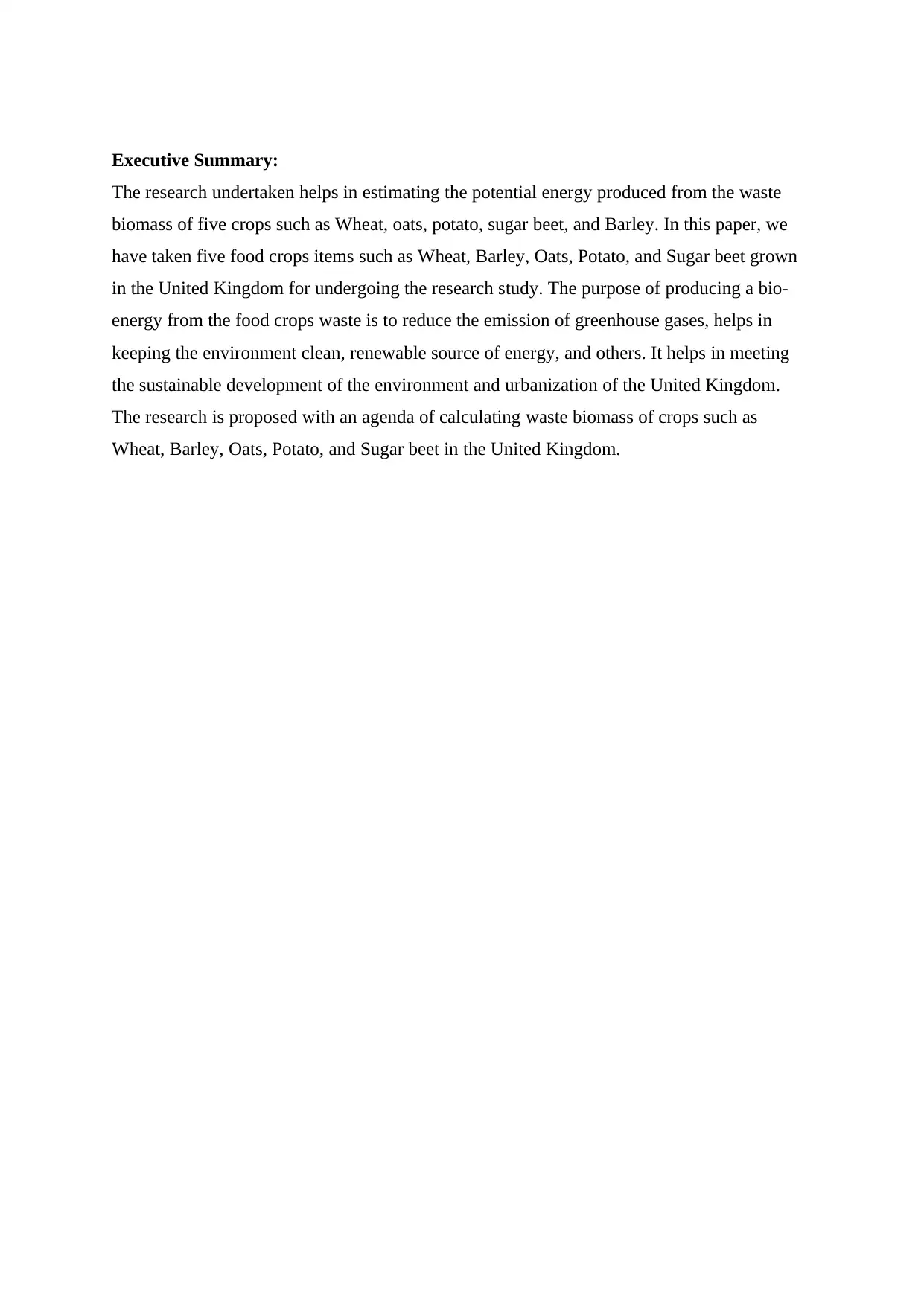
Executive Summary:
The research undertaken helps in estimating the potential energy produced from the waste
biomass of five crops such as Wheat, oats, potato, sugar beet, and Barley. In this paper, we
have taken five food crops items such as Wheat, Barley, Oats, Potato, and Sugar beet grown
in the United Kingdom for undergoing the research study. The purpose of producing a bio-
energy from the food crops waste is to reduce the emission of greenhouse gases, helps in
keeping the environment clean, renewable source of energy, and others. It helps in meeting
the sustainable development of the environment and urbanization of the United Kingdom.
The research is proposed with an agenda of calculating waste biomass of crops such as
Wheat, Barley, Oats, Potato, and Sugar beet in the United Kingdom.
The research undertaken helps in estimating the potential energy produced from the waste
biomass of five crops such as Wheat, oats, potato, sugar beet, and Barley. In this paper, we
have taken five food crops items such as Wheat, Barley, Oats, Potato, and Sugar beet grown
in the United Kingdom for undergoing the research study. The purpose of producing a bio-
energy from the food crops waste is to reduce the emission of greenhouse gases, helps in
keeping the environment clean, renewable source of energy, and others. It helps in meeting
the sustainable development of the environment and urbanization of the United Kingdom.
The research is proposed with an agenda of calculating waste biomass of crops such as
Wheat, Barley, Oats, Potato, and Sugar beet in the United Kingdom.
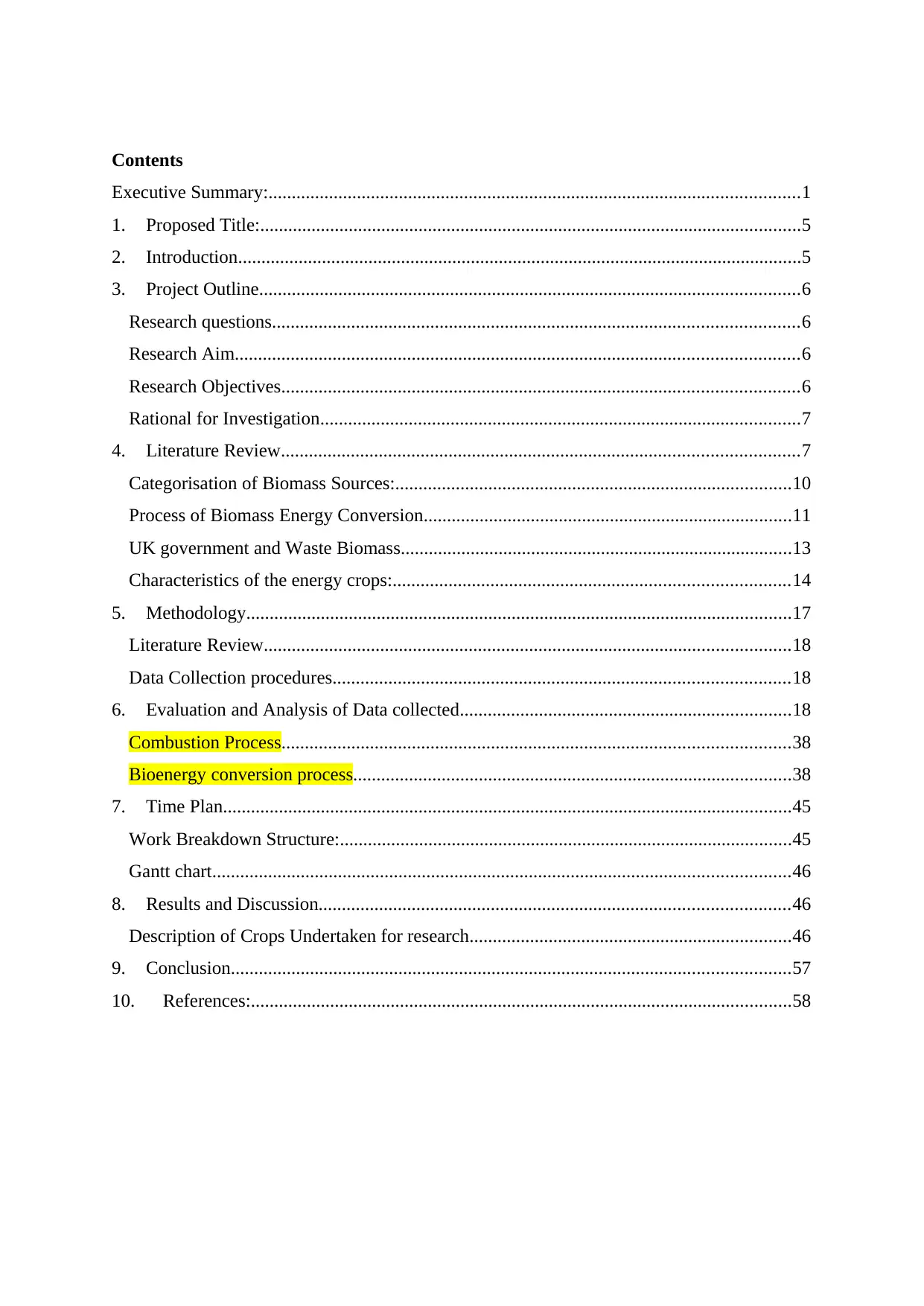
Contents
Executive Summary:..................................................................................................................1
1. Proposed Title:....................................................................................................................5
2. Introduction.........................................................................................................................5
3. Project Outline....................................................................................................................6
Research questions.................................................................................................................6
Research Aim.........................................................................................................................6
Research Objectives...............................................................................................................6
Rational for Investigation.......................................................................................................7
4. Literature Review...............................................................................................................7
Categorisation of Biomass Sources:.....................................................................................10
Process of Biomass Energy Conversion...............................................................................11
UK government and Waste Biomass....................................................................................13
Characteristics of the energy crops:.....................................................................................14
5. Methodology.....................................................................................................................17
Literature Review.................................................................................................................18
Data Collection procedures..................................................................................................18
6. Evaluation and Analysis of Data collected.......................................................................18
Combustion Process.............................................................................................................38
Bioenergy conversion process..............................................................................................38
7. Time Plan..........................................................................................................................45
Work Breakdown Structure:.................................................................................................45
Gantt chart............................................................................................................................46
8. Results and Discussion.....................................................................................................46
Description of Crops Undertaken for research.....................................................................46
9. Conclusion........................................................................................................................57
10. References:....................................................................................................................58
Executive Summary:..................................................................................................................1
1. Proposed Title:....................................................................................................................5
2. Introduction.........................................................................................................................5
3. Project Outline....................................................................................................................6
Research questions.................................................................................................................6
Research Aim.........................................................................................................................6
Research Objectives...............................................................................................................6
Rational for Investigation.......................................................................................................7
4. Literature Review...............................................................................................................7
Categorisation of Biomass Sources:.....................................................................................10
Process of Biomass Energy Conversion...............................................................................11
UK government and Waste Biomass....................................................................................13
Characteristics of the energy crops:.....................................................................................14
5. Methodology.....................................................................................................................17
Literature Review.................................................................................................................18
Data Collection procedures..................................................................................................18
6. Evaluation and Analysis of Data collected.......................................................................18
Combustion Process.............................................................................................................38
Bioenergy conversion process..............................................................................................38
7. Time Plan..........................................................................................................................45
Work Breakdown Structure:.................................................................................................45
Gantt chart............................................................................................................................46
8. Results and Discussion.....................................................................................................46
Description of Crops Undertaken for research.....................................................................46
9. Conclusion........................................................................................................................57
10. References:....................................................................................................................58
⊘ This is a preview!⊘
Do you want full access?
Subscribe today to unlock all pages.

Trusted by 1+ million students worldwide
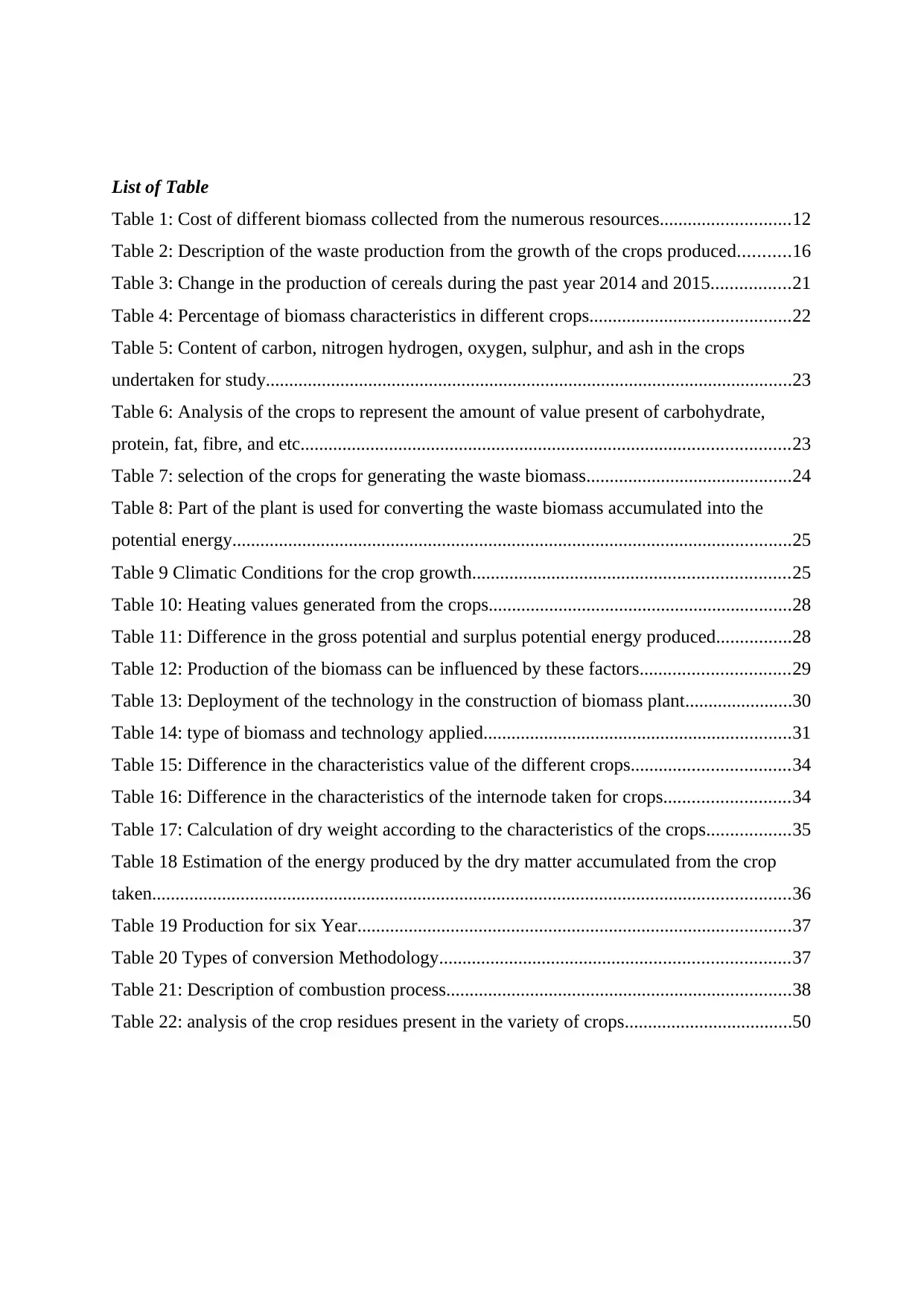
List of Table
Table 1: Cost of different biomass collected from the numerous resources............................12
Table 2: Description of the waste production from the growth of the crops produced...........16
Table 3: Change in the production of cereals during the past year 2014 and 2015.................21
Table 4: Percentage of biomass characteristics in different crops...........................................22
Table 5: Content of carbon, nitrogen hydrogen, oxygen, sulphur, and ash in the crops
undertaken for study.................................................................................................................23
Table 6: Analysis of the crops to represent the amount of value present of carbohydrate,
protein, fat, fibre, and etc.........................................................................................................23
Table 7: selection of the crops for generating the waste biomass............................................24
Table 8: Part of the plant is used for converting the waste biomass accumulated into the
potential energy........................................................................................................................25
Table 9 Climatic Conditions for the crop growth....................................................................25
Table 10: Heating values generated from the crops.................................................................28
Table 11: Difference in the gross potential and surplus potential energy produced................28
Table 12: Production of the biomass can be influenced by these factors................................29
Table 13: Deployment of the technology in the construction of biomass plant.......................30
Table 14: type of biomass and technology applied..................................................................31
Table 15: Difference in the characteristics value of the different crops..................................34
Table 16: Difference in the characteristics of the internode taken for crops...........................34
Table 17: Calculation of dry weight according to the characteristics of the crops..................35
Table 18 Estimation of the energy produced by the dry matter accumulated from the crop
taken.........................................................................................................................................36
Table 19 Production for six Year.............................................................................................37
Table 20 Types of conversion Methodology...........................................................................37
Table 21: Description of combustion process..........................................................................38
Table 22: analysis of the crop residues present in the variety of crops....................................50
Table 1: Cost of different biomass collected from the numerous resources............................12
Table 2: Description of the waste production from the growth of the crops produced...........16
Table 3: Change in the production of cereals during the past year 2014 and 2015.................21
Table 4: Percentage of biomass characteristics in different crops...........................................22
Table 5: Content of carbon, nitrogen hydrogen, oxygen, sulphur, and ash in the crops
undertaken for study.................................................................................................................23
Table 6: Analysis of the crops to represent the amount of value present of carbohydrate,
protein, fat, fibre, and etc.........................................................................................................23
Table 7: selection of the crops for generating the waste biomass............................................24
Table 8: Part of the plant is used for converting the waste biomass accumulated into the
potential energy........................................................................................................................25
Table 9 Climatic Conditions for the crop growth....................................................................25
Table 10: Heating values generated from the crops.................................................................28
Table 11: Difference in the gross potential and surplus potential energy produced................28
Table 12: Production of the biomass can be influenced by these factors................................29
Table 13: Deployment of the technology in the construction of biomass plant.......................30
Table 14: type of biomass and technology applied..................................................................31
Table 15: Difference in the characteristics value of the different crops..................................34
Table 16: Difference in the characteristics of the internode taken for crops...........................34
Table 17: Calculation of dry weight according to the characteristics of the crops..................35
Table 18 Estimation of the energy produced by the dry matter accumulated from the crop
taken.........................................................................................................................................36
Table 19 Production for six Year.............................................................................................37
Table 20 Types of conversion Methodology...........................................................................37
Table 21: Description of combustion process..........................................................................38
Table 22: analysis of the crop residues present in the variety of crops....................................50
Paraphrase This Document
Need a fresh take? Get an instant paraphrase of this document with our AI Paraphraser
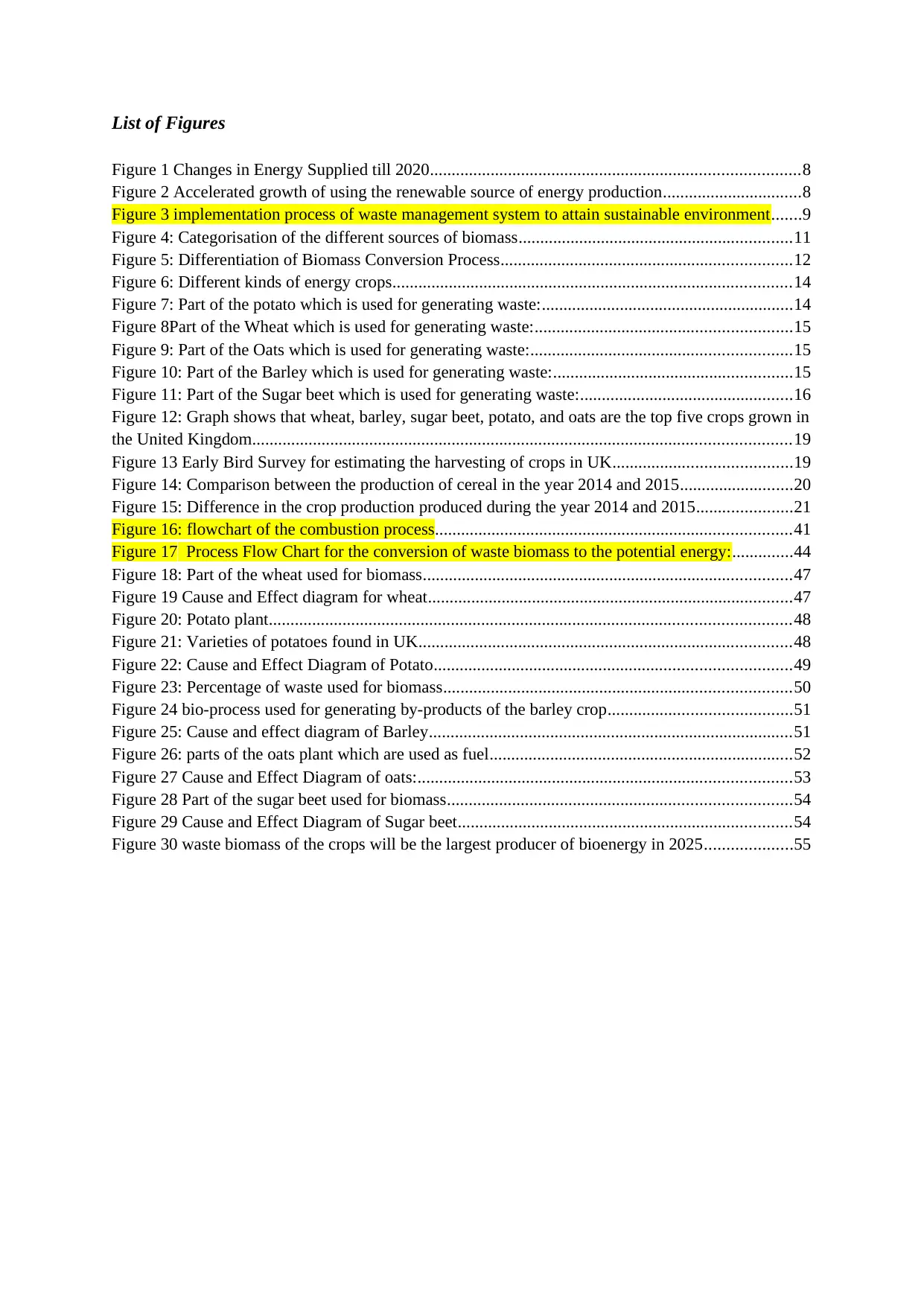
List of Figures
Figure 1 Changes in Energy Supplied till 2020.....................................................................................8
Figure 2 Accelerated growth of using the renewable source of energy production................................8
Figure 3 implementation process of waste management system to attain sustainable environment.......9
Figure 4: Categorisation of the different sources of biomass...............................................................11
Figure 5: Differentiation of Biomass Conversion Process...................................................................12
Figure 6: Different kinds of energy crops............................................................................................14
Figure 7: Part of the potato which is used for generating waste:..........................................................14
Figure 8Part of the Wheat which is used for generating waste:...........................................................15
Figure 9: Part of the Oats which is used for generating waste:............................................................15
Figure 10: Part of the Barley which is used for generating waste:.......................................................15
Figure 11: Part of the Sugar beet which is used for generating waste:.................................................16
Figure 12: Graph shows that wheat, barley, sugar beet, potato, and oats are the top five crops grown in
the United Kingdom............................................................................................................................19
Figure 13 Early Bird Survey for estimating the harvesting of crops in UK.........................................19
Figure 14: Comparison between the production of cereal in the year 2014 and 2015..........................20
Figure 15: Difference in the crop production produced during the year 2014 and 2015......................21
Figure 16: flowchart of the combustion process..................................................................................41
Figure 17 Process Flow Chart for the conversion of waste biomass to the potential energy:..............44
Figure 18: Part of the wheat used for biomass.....................................................................................47
Figure 19 Cause and Effect diagram for wheat....................................................................................47
Figure 20: Potato plant........................................................................................................................48
Figure 21: Varieties of potatoes found in UK......................................................................................48
Figure 22: Cause and Effect Diagram of Potato..................................................................................49
Figure 23: Percentage of waste used for biomass................................................................................50
Figure 24 bio-process used for generating by-products of the barley crop..........................................51
Figure 25: Cause and effect diagram of Barley....................................................................................51
Figure 26: parts of the oats plant which are used as fuel......................................................................52
Figure 27 Cause and Effect Diagram of oats:......................................................................................53
Figure 28 Part of the sugar beet used for biomass...............................................................................54
Figure 29 Cause and Effect Diagram of Sugar beet.............................................................................54
Figure 30 waste biomass of the crops will be the largest producer of bioenergy in 2025....................55
Figure 1 Changes in Energy Supplied till 2020.....................................................................................8
Figure 2 Accelerated growth of using the renewable source of energy production................................8
Figure 3 implementation process of waste management system to attain sustainable environment.......9
Figure 4: Categorisation of the different sources of biomass...............................................................11
Figure 5: Differentiation of Biomass Conversion Process...................................................................12
Figure 6: Different kinds of energy crops............................................................................................14
Figure 7: Part of the potato which is used for generating waste:..........................................................14
Figure 8Part of the Wheat which is used for generating waste:...........................................................15
Figure 9: Part of the Oats which is used for generating waste:............................................................15
Figure 10: Part of the Barley which is used for generating waste:.......................................................15
Figure 11: Part of the Sugar beet which is used for generating waste:.................................................16
Figure 12: Graph shows that wheat, barley, sugar beet, potato, and oats are the top five crops grown in
the United Kingdom............................................................................................................................19
Figure 13 Early Bird Survey for estimating the harvesting of crops in UK.........................................19
Figure 14: Comparison between the production of cereal in the year 2014 and 2015..........................20
Figure 15: Difference in the crop production produced during the year 2014 and 2015......................21
Figure 16: flowchart of the combustion process..................................................................................41
Figure 17 Process Flow Chart for the conversion of waste biomass to the potential energy:..............44
Figure 18: Part of the wheat used for biomass.....................................................................................47
Figure 19 Cause and Effect diagram for wheat....................................................................................47
Figure 20: Potato plant........................................................................................................................48
Figure 21: Varieties of potatoes found in UK......................................................................................48
Figure 22: Cause and Effect Diagram of Potato..................................................................................49
Figure 23: Percentage of waste used for biomass................................................................................50
Figure 24 bio-process used for generating by-products of the barley crop..........................................51
Figure 25: Cause and effect diagram of Barley....................................................................................51
Figure 26: parts of the oats plant which are used as fuel......................................................................52
Figure 27 Cause and Effect Diagram of oats:......................................................................................53
Figure 28 Part of the sugar beet used for biomass...............................................................................54
Figure 29 Cause and Effect Diagram of Sugar beet.............................................................................54
Figure 30 waste biomass of the crops will be the largest producer of bioenergy in 2025....................55
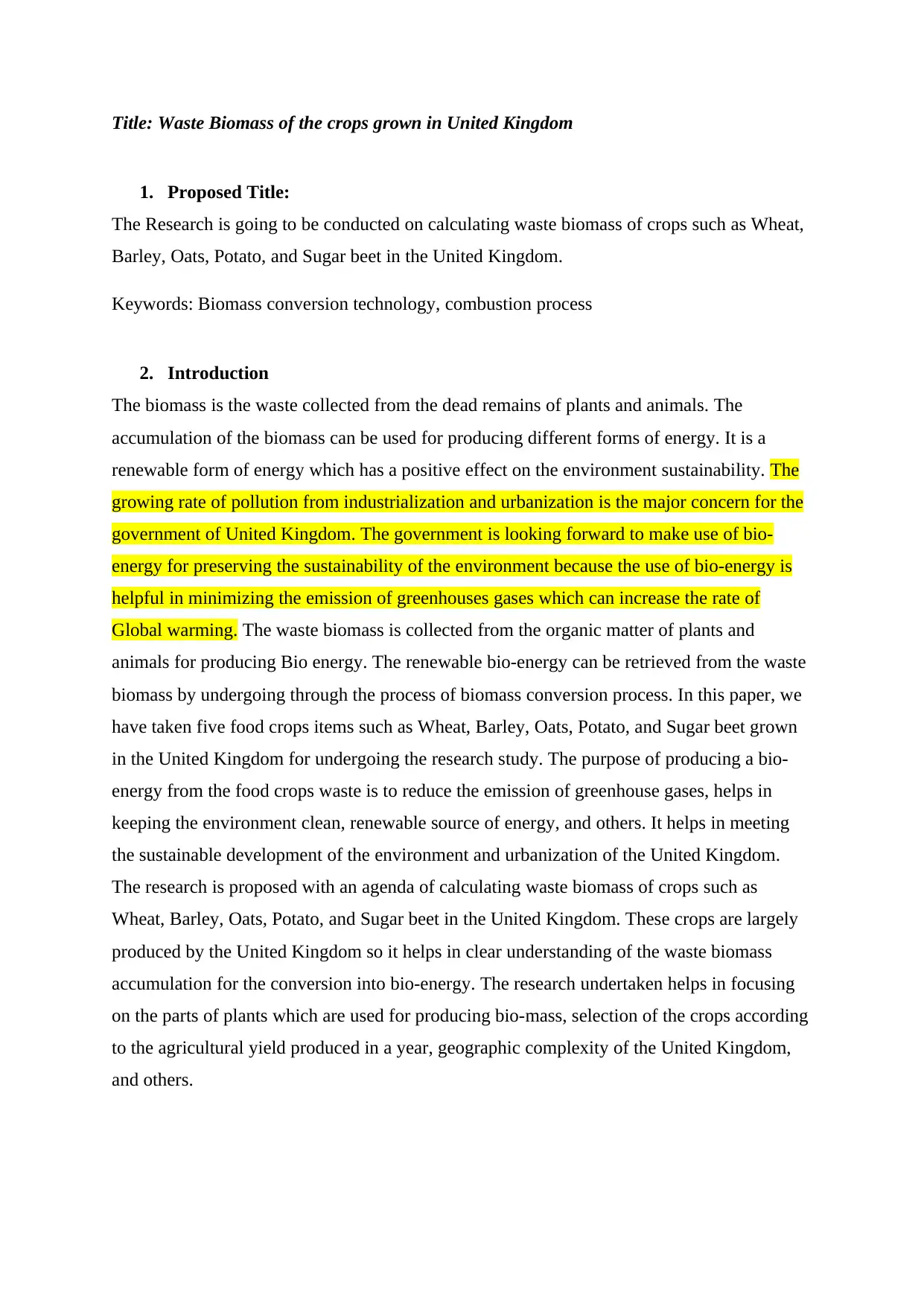
Title: Waste Biomass of the crops grown in United Kingdom
1. Proposed Title:
The Research is going to be conducted on calculating waste biomass of crops such as Wheat,
Barley, Oats, Potato, and Sugar beet in the United Kingdom.
Keywords: Biomass conversion technology, combustion process
2. Introduction
The biomass is the waste collected from the dead remains of plants and animals. The
accumulation of the biomass can be used for producing different forms of energy. It is a
renewable form of energy which has a positive effect on the environment sustainability. The
growing rate of pollution from industrialization and urbanization is the major concern for the
government of United Kingdom. The government is looking forward to make use of bio-
energy for preserving the sustainability of the environment because the use of bio-energy is
helpful in minimizing the emission of greenhouses gases which can increase the rate of
Global warming. The waste biomass is collected from the organic matter of plants and
animals for producing Bio energy. The renewable bio-energy can be retrieved from the waste
biomass by undergoing through the process of biomass conversion process. In this paper, we
have taken five food crops items such as Wheat, Barley, Oats, Potato, and Sugar beet grown
in the United Kingdom for undergoing the research study. The purpose of producing a bio-
energy from the food crops waste is to reduce the emission of greenhouse gases, helps in
keeping the environment clean, renewable source of energy, and others. It helps in meeting
the sustainable development of the environment and urbanization of the United Kingdom.
The research is proposed with an agenda of calculating waste biomass of crops such as
Wheat, Barley, Oats, Potato, and Sugar beet in the United Kingdom. These crops are largely
produced by the United Kingdom so it helps in clear understanding of the waste biomass
accumulation for the conversion into bio-energy. The research undertaken helps in focusing
on the parts of plants which are used for producing bio-mass, selection of the crops according
to the agricultural yield produced in a year, geographic complexity of the United Kingdom,
and others.
1. Proposed Title:
The Research is going to be conducted on calculating waste biomass of crops such as Wheat,
Barley, Oats, Potato, and Sugar beet in the United Kingdom.
Keywords: Biomass conversion technology, combustion process
2. Introduction
The biomass is the waste collected from the dead remains of plants and animals. The
accumulation of the biomass can be used for producing different forms of energy. It is a
renewable form of energy which has a positive effect on the environment sustainability. The
growing rate of pollution from industrialization and urbanization is the major concern for the
government of United Kingdom. The government is looking forward to make use of bio-
energy for preserving the sustainability of the environment because the use of bio-energy is
helpful in minimizing the emission of greenhouses gases which can increase the rate of
Global warming. The waste biomass is collected from the organic matter of plants and
animals for producing Bio energy. The renewable bio-energy can be retrieved from the waste
biomass by undergoing through the process of biomass conversion process. In this paper, we
have taken five food crops items such as Wheat, Barley, Oats, Potato, and Sugar beet grown
in the United Kingdom for undergoing the research study. The purpose of producing a bio-
energy from the food crops waste is to reduce the emission of greenhouse gases, helps in
keeping the environment clean, renewable source of energy, and others. It helps in meeting
the sustainable development of the environment and urbanization of the United Kingdom.
The research is proposed with an agenda of calculating waste biomass of crops such as
Wheat, Barley, Oats, Potato, and Sugar beet in the United Kingdom. These crops are largely
produced by the United Kingdom so it helps in clear understanding of the waste biomass
accumulation for the conversion into bio-energy. The research undertaken helps in focusing
on the parts of plants which are used for producing bio-mass, selection of the crops according
to the agricultural yield produced in a year, geographic complexity of the United Kingdom,
and others.
⊘ This is a preview!⊘
Do you want full access?
Subscribe today to unlock all pages.

Trusted by 1+ million students worldwide
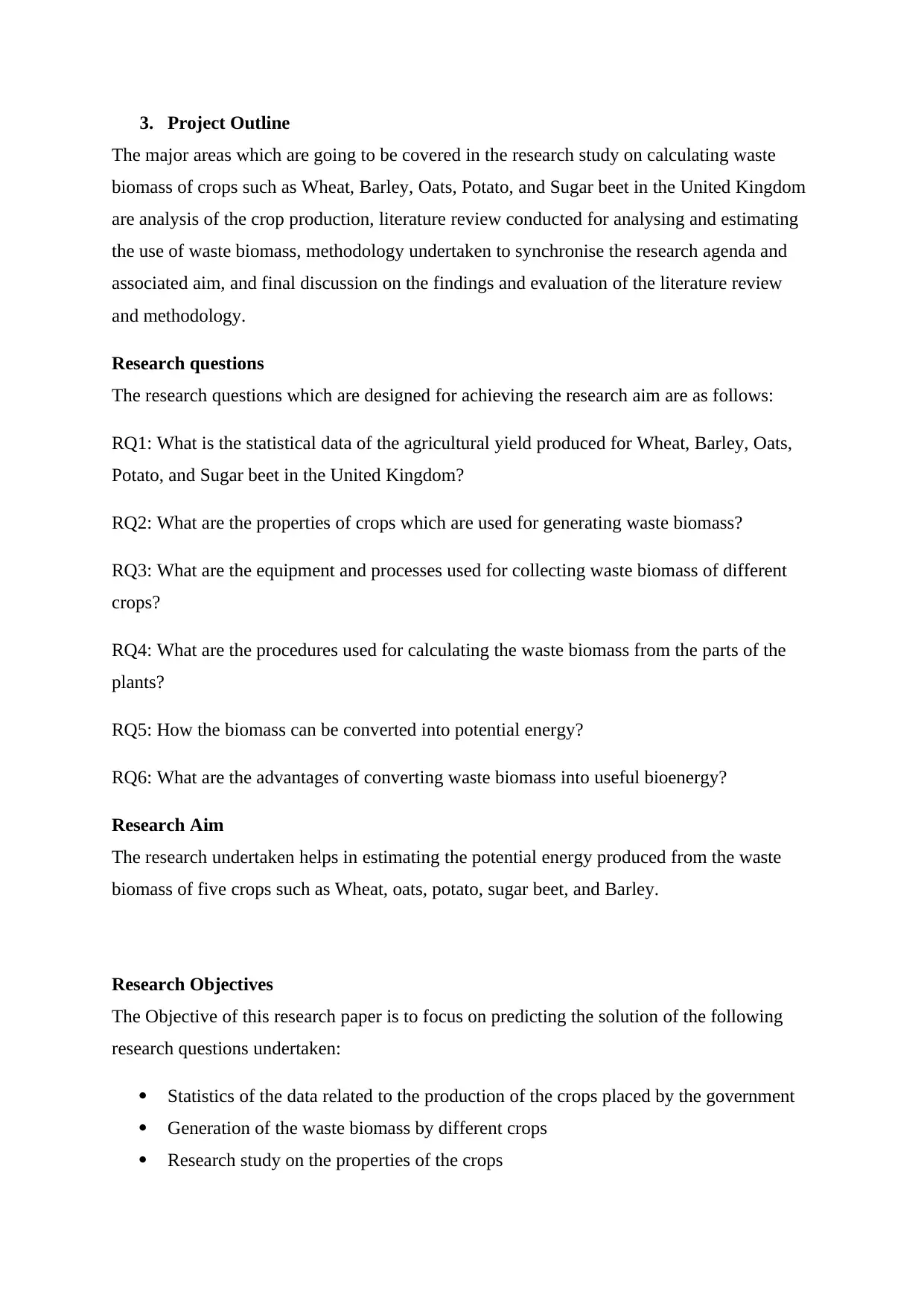
3. Project Outline
The major areas which are going to be covered in the research study on calculating waste
biomass of crops such as Wheat, Barley, Oats, Potato, and Sugar beet in the United Kingdom
are analysis of the crop production, literature review conducted for analysing and estimating
the use of waste biomass, methodology undertaken to synchronise the research agenda and
associated aim, and final discussion on the findings and evaluation of the literature review
and methodology.
Research questions
The research questions which are designed for achieving the research aim are as follows:
RQ1: What is the statistical data of the agricultural yield produced for Wheat, Barley, Oats,
Potato, and Sugar beet in the United Kingdom?
RQ2: What are the properties of crops which are used for generating waste biomass?
RQ3: What are the equipment and processes used for collecting waste biomass of different
crops?
RQ4: What are the procedures used for calculating the waste biomass from the parts of the
plants?
RQ5: How the biomass can be converted into potential energy?
RQ6: What are the advantages of converting waste biomass into useful bioenergy?
Research Aim
The research undertaken helps in estimating the potential energy produced from the waste
biomass of five crops such as Wheat, oats, potato, sugar beet, and Barley.
Research Objectives
The Objective of this research paper is to focus on predicting the solution of the following
research questions undertaken:
Statistics of the data related to the production of the crops placed by the government
Generation of the waste biomass by different crops
Research study on the properties of the crops
The major areas which are going to be covered in the research study on calculating waste
biomass of crops such as Wheat, Barley, Oats, Potato, and Sugar beet in the United Kingdom
are analysis of the crop production, literature review conducted for analysing and estimating
the use of waste biomass, methodology undertaken to synchronise the research agenda and
associated aim, and final discussion on the findings and evaluation of the literature review
and methodology.
Research questions
The research questions which are designed for achieving the research aim are as follows:
RQ1: What is the statistical data of the agricultural yield produced for Wheat, Barley, Oats,
Potato, and Sugar beet in the United Kingdom?
RQ2: What are the properties of crops which are used for generating waste biomass?
RQ3: What are the equipment and processes used for collecting waste biomass of different
crops?
RQ4: What are the procedures used for calculating the waste biomass from the parts of the
plants?
RQ5: How the biomass can be converted into potential energy?
RQ6: What are the advantages of converting waste biomass into useful bioenergy?
Research Aim
The research undertaken helps in estimating the potential energy produced from the waste
biomass of five crops such as Wheat, oats, potato, sugar beet, and Barley.
Research Objectives
The Objective of this research paper is to focus on predicting the solution of the following
research questions undertaken:
Statistics of the data related to the production of the crops placed by the government
Generation of the waste biomass by different crops
Research study on the properties of the crops
Paraphrase This Document
Need a fresh take? Get an instant paraphrase of this document with our AI Paraphraser
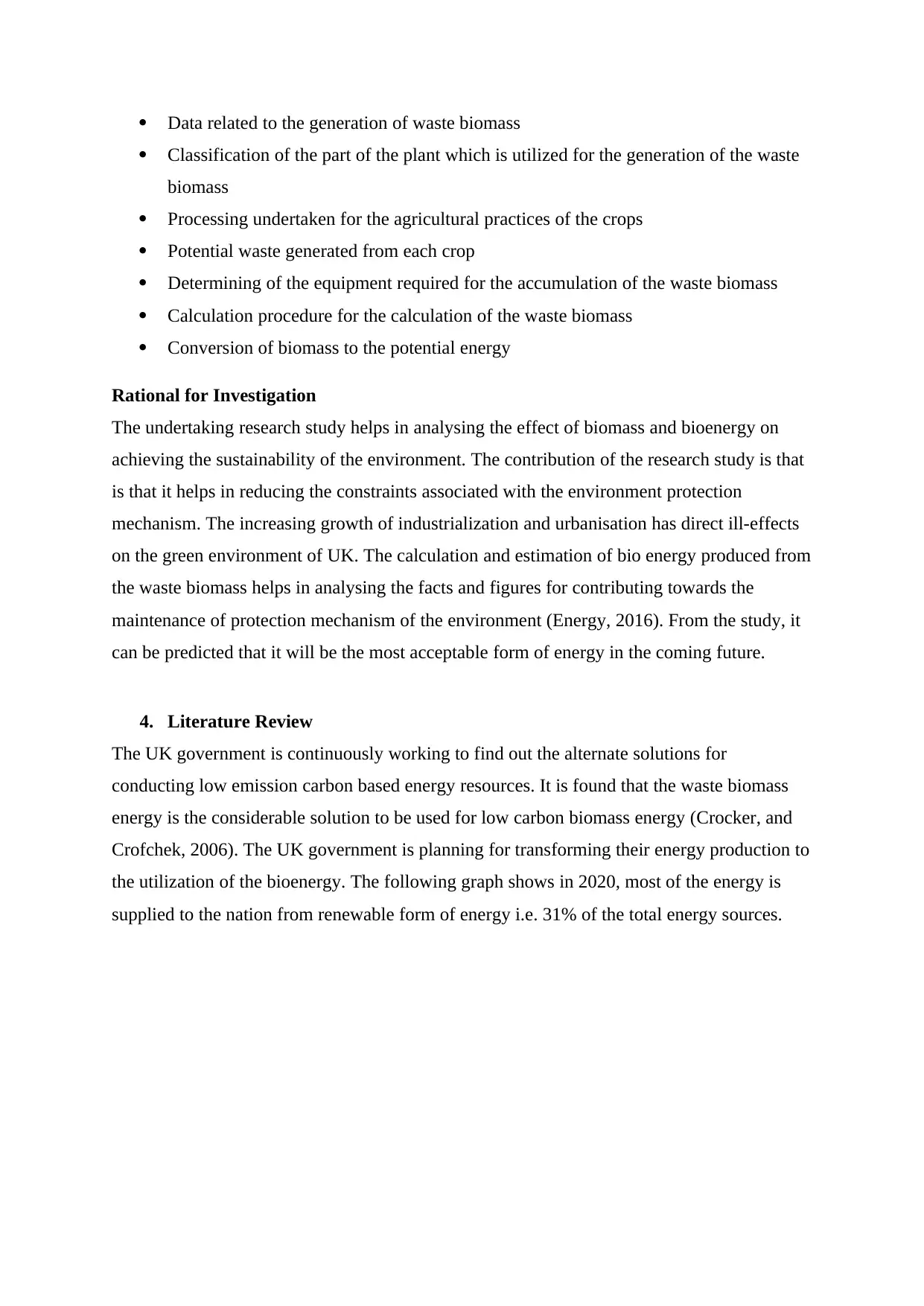
Data related to the generation of waste biomass
Classification of the part of the plant which is utilized for the generation of the waste
biomass
Processing undertaken for the agricultural practices of the crops
Potential waste generated from each crop
Determining of the equipment required for the accumulation of the waste biomass
Calculation procedure for the calculation of the waste biomass
Conversion of biomass to the potential energy
Rational for Investigation
The undertaking research study helps in analysing the effect of biomass and bioenergy on
achieving the sustainability of the environment. The contribution of the research study is that
is that it helps in reducing the constraints associated with the environment protection
mechanism. The increasing growth of industrialization and urbanisation has direct ill-effects
on the green environment of UK. The calculation and estimation of bio energy produced from
the waste biomass helps in analysing the facts and figures for contributing towards the
maintenance of protection mechanism of the environment (Energy, 2016). From the study, it
can be predicted that it will be the most acceptable form of energy in the coming future.
4. Literature Review
The UK government is continuously working to find out the alternate solutions for
conducting low emission carbon based energy resources. It is found that the waste biomass
energy is the considerable solution to be used for low carbon biomass energy (Crocker, and
Crofchek, 2006). The UK government is planning for transforming their energy production to
the utilization of the bioenergy. The following graph shows in 2020, most of the energy is
supplied to the nation from renewable form of energy i.e. 31% of the total energy sources.
Classification of the part of the plant which is utilized for the generation of the waste
biomass
Processing undertaken for the agricultural practices of the crops
Potential waste generated from each crop
Determining of the equipment required for the accumulation of the waste biomass
Calculation procedure for the calculation of the waste biomass
Conversion of biomass to the potential energy
Rational for Investigation
The undertaking research study helps in analysing the effect of biomass and bioenergy on
achieving the sustainability of the environment. The contribution of the research study is that
is that it helps in reducing the constraints associated with the environment protection
mechanism. The increasing growth of industrialization and urbanisation has direct ill-effects
on the green environment of UK. The calculation and estimation of bio energy produced from
the waste biomass helps in analysing the facts and figures for contributing towards the
maintenance of protection mechanism of the environment (Energy, 2016). From the study, it
can be predicted that it will be the most acceptable form of energy in the coming future.
4. Literature Review
The UK government is continuously working to find out the alternate solutions for
conducting low emission carbon based energy resources. It is found that the waste biomass
energy is the considerable solution to be used for low carbon biomass energy (Crocker, and
Crofchek, 2006). The UK government is planning for transforming their energy production to
the utilization of the bioenergy. The following graph shows in 2020, most of the energy is
supplied to the nation from renewable form of energy i.e. 31% of the total energy sources.
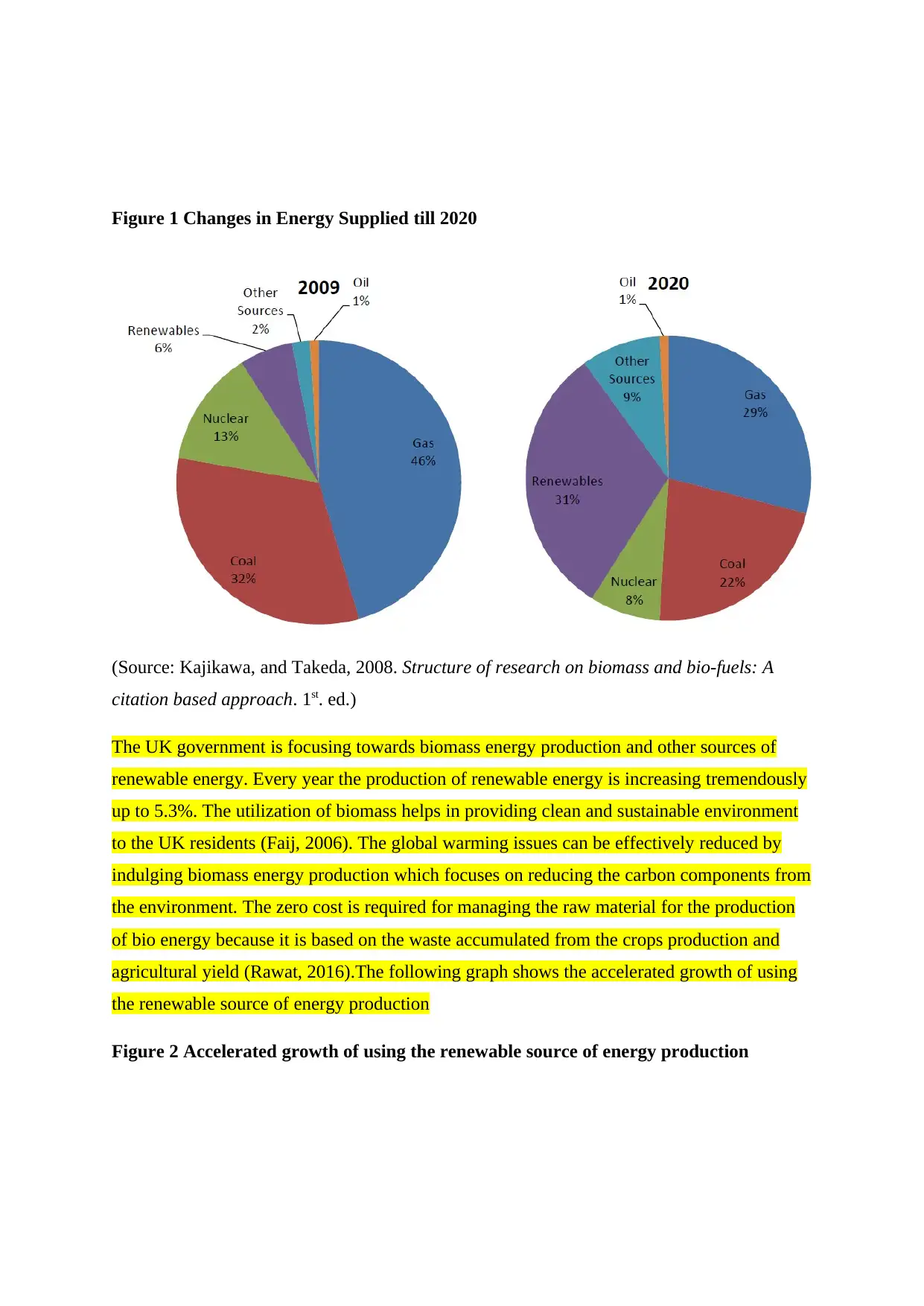
Figure 1 Changes in Energy Supplied till 2020
(Source: Kajikawa, and Takeda, 2008. Structure of research on biomass and bio-fuels: A
citation based approach. 1st. ed.)
The UK government is focusing towards biomass energy production and other sources of
renewable energy. Every year the production of renewable energy is increasing tremendously
up to 5.3%. The utilization of biomass helps in providing clean and sustainable environment
to the UK residents (Faij, 2006). The global warming issues can be effectively reduced by
indulging biomass energy production which focuses on reducing the carbon components from
the environment. The zero cost is required for managing the raw material for the production
of bio energy because it is based on the waste accumulated from the crops production and
agricultural yield (Rawat, 2016).The following graph shows the accelerated growth of using
the renewable source of energy production
Figure 2 Accelerated growth of using the renewable source of energy production
(Source: Kajikawa, and Takeda, 2008. Structure of research on biomass and bio-fuels: A
citation based approach. 1st. ed.)
The UK government is focusing towards biomass energy production and other sources of
renewable energy. Every year the production of renewable energy is increasing tremendously
up to 5.3%. The utilization of biomass helps in providing clean and sustainable environment
to the UK residents (Faij, 2006). The global warming issues can be effectively reduced by
indulging biomass energy production which focuses on reducing the carbon components from
the environment. The zero cost is required for managing the raw material for the production
of bio energy because it is based on the waste accumulated from the crops production and
agricultural yield (Rawat, 2016).The following graph shows the accelerated growth of using
the renewable source of energy production
Figure 2 Accelerated growth of using the renewable source of energy production
⊘ This is a preview!⊘
Do you want full access?
Subscribe today to unlock all pages.

Trusted by 1+ million students worldwide
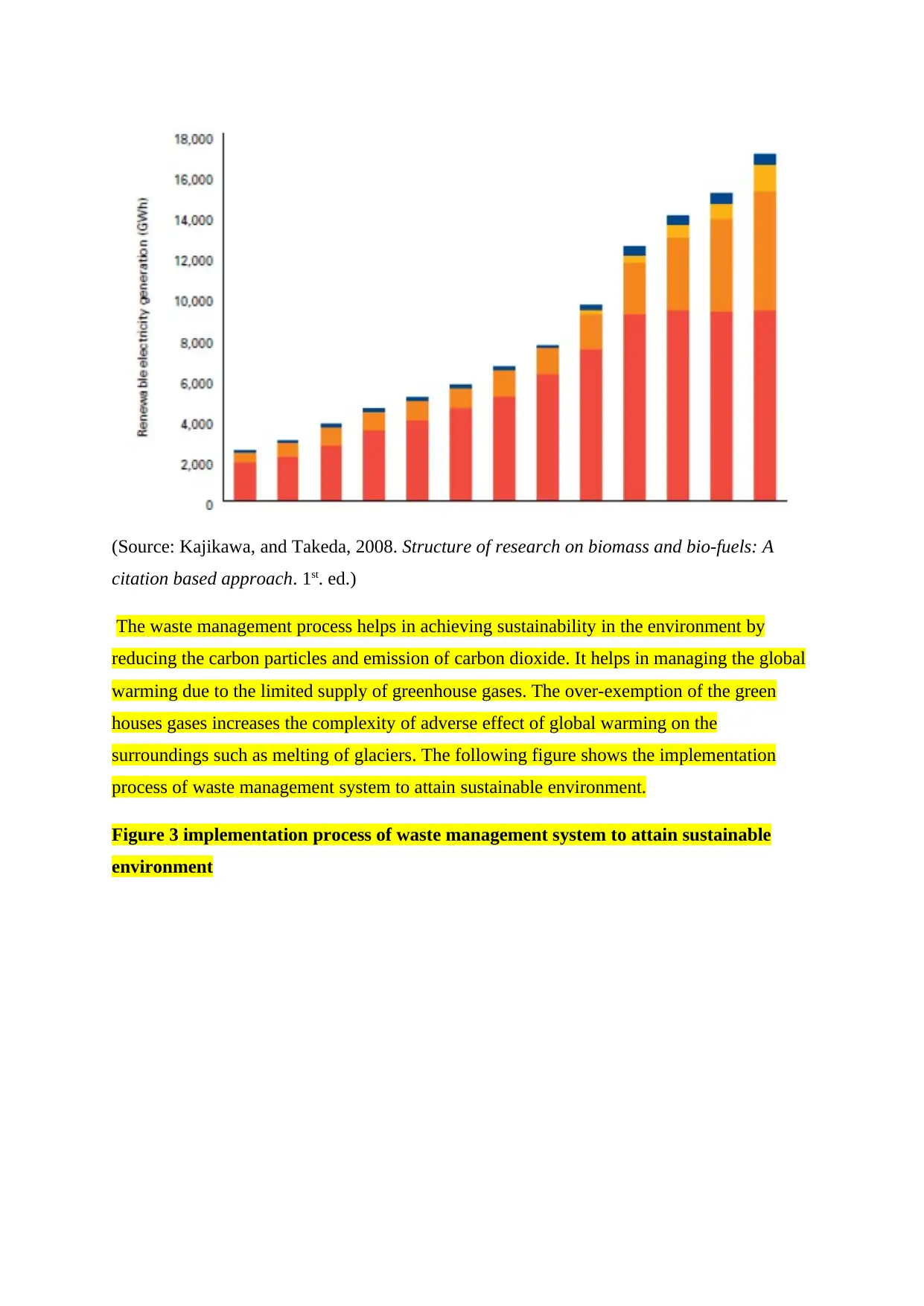
(Source: Kajikawa, and Takeda, 2008. Structure of research on biomass and bio-fuels: A
citation based approach. 1st. ed.)
The waste management process helps in achieving sustainability in the environment by
reducing the carbon particles and emission of carbon dioxide. It helps in managing the global
warming due to the limited supply of greenhouse gases. The over-exemption of the green
houses gases increases the complexity of adverse effect of global warming on the
surroundings such as melting of glaciers. The following figure shows the implementation
process of waste management system to attain sustainable environment.
Figure 3 implementation process of waste management system to attain sustainable
environment
citation based approach. 1st. ed.)
The waste management process helps in achieving sustainability in the environment by
reducing the carbon particles and emission of carbon dioxide. It helps in managing the global
warming due to the limited supply of greenhouse gases. The over-exemption of the green
houses gases increases the complexity of adverse effect of global warming on the
surroundings such as melting of glaciers. The following figure shows the implementation
process of waste management system to attain sustainable environment.
Figure 3 implementation process of waste management system to attain sustainable
environment
Paraphrase This Document
Need a fresh take? Get an instant paraphrase of this document with our AI Paraphraser
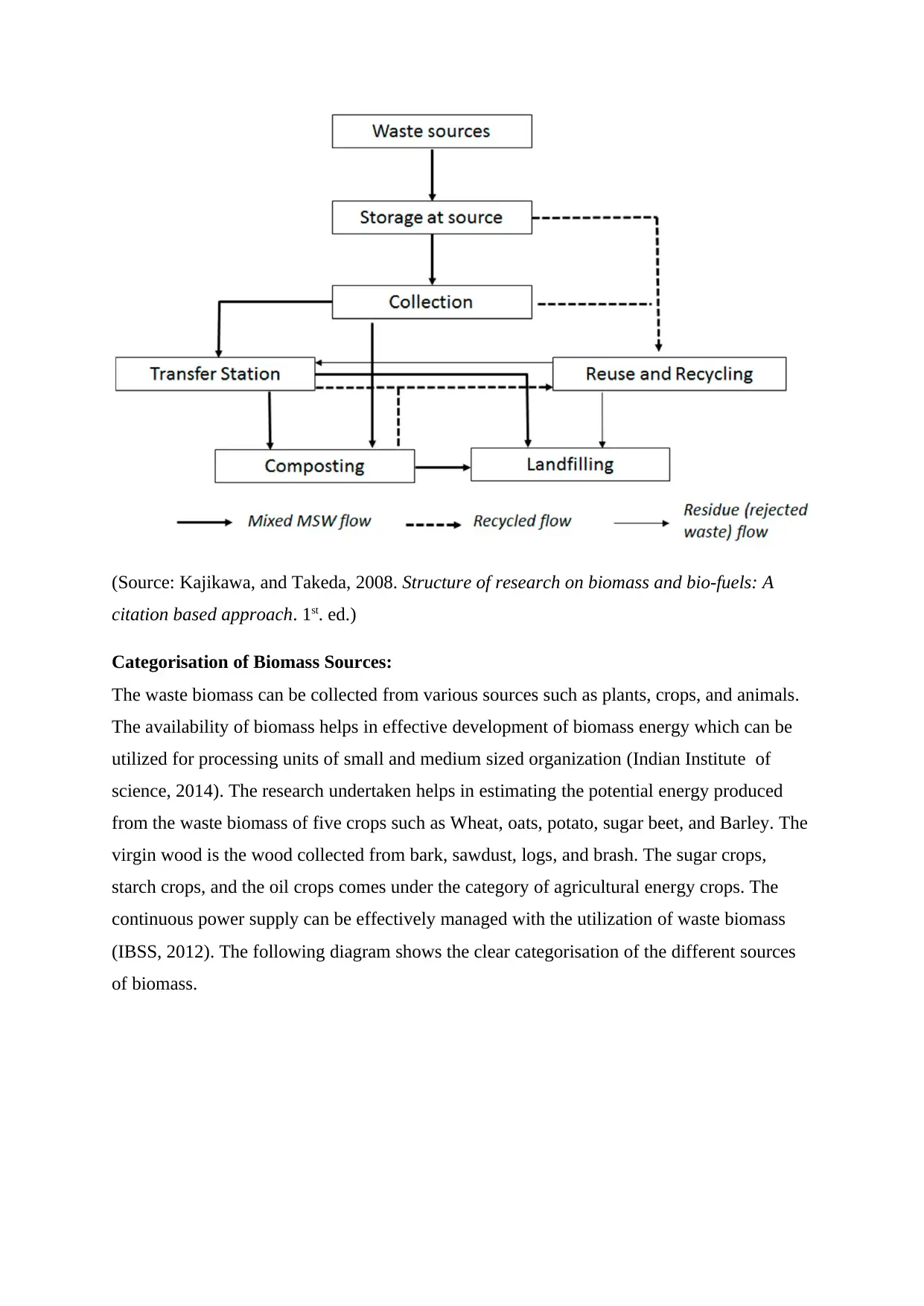
(Source: Kajikawa, and Takeda, 2008. Structure of research on biomass and bio-fuels: A
citation based approach. 1st. ed.)
Categorisation of Biomass Sources:
The waste biomass can be collected from various sources such as plants, crops, and animals.
The availability of biomass helps in effective development of biomass energy which can be
utilized for processing units of small and medium sized organization (Indian Institute of
science, 2014). The research undertaken helps in estimating the potential energy produced
from the waste biomass of five crops such as Wheat, oats, potato, sugar beet, and Barley. The
virgin wood is the wood collected from bark, sawdust, logs, and brash. The sugar crops,
starch crops, and the oil crops comes under the category of agricultural energy crops. The
continuous power supply can be effectively managed with the utilization of waste biomass
(IBSS, 2012). The following diagram shows the clear categorisation of the different sources
of biomass.
citation based approach. 1st. ed.)
Categorisation of Biomass Sources:
The waste biomass can be collected from various sources such as plants, crops, and animals.
The availability of biomass helps in effective development of biomass energy which can be
utilized for processing units of small and medium sized organization (Indian Institute of
science, 2014). The research undertaken helps in estimating the potential energy produced
from the waste biomass of five crops such as Wheat, oats, potato, sugar beet, and Barley. The
virgin wood is the wood collected from bark, sawdust, logs, and brash. The sugar crops,
starch crops, and the oil crops comes under the category of agricultural energy crops. The
continuous power supply can be effectively managed with the utilization of waste biomass
(IBSS, 2012). The following diagram shows the clear categorisation of the different sources
of biomass.
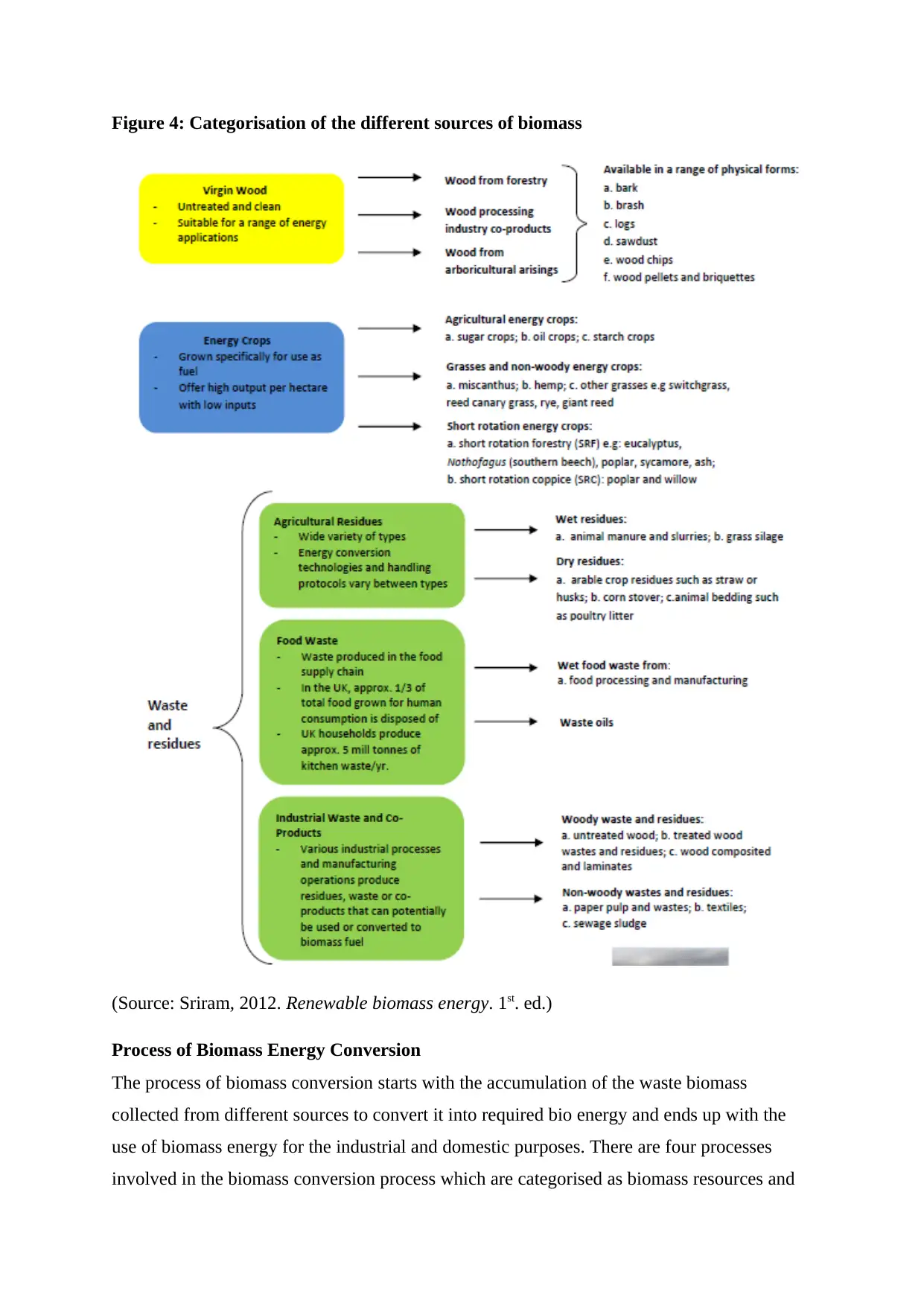
Figure 4: Categorisation of the different sources of biomass
(Source: Sriram, 2012. Renewable biomass energy. 1st. ed.)
Process of Biomass Energy Conversion
The process of biomass conversion starts with the accumulation of the waste biomass
collected from different sources to convert it into required bio energy and ends up with the
use of biomass energy for the industrial and domestic purposes. There are four processes
involved in the biomass conversion process which are categorised as biomass resources and
(Source: Sriram, 2012. Renewable biomass energy. 1st. ed.)
Process of Biomass Energy Conversion
The process of biomass conversion starts with the accumulation of the waste biomass
collected from different sources to convert it into required bio energy and ends up with the
use of biomass energy for the industrial and domestic purposes. There are four processes
involved in the biomass conversion process which are categorised as biomass resources and
⊘ This is a preview!⊘
Do you want full access?
Subscribe today to unlock all pages.

Trusted by 1+ million students worldwide
1 out of 63
Your All-in-One AI-Powered Toolkit for Academic Success.
+13062052269
info@desklib.com
Available 24*7 on WhatsApp / Email
![[object Object]](/_next/static/media/star-bottom.7253800d.svg)
Unlock your academic potential
Copyright © 2020–2025 A2Z Services. All Rights Reserved. Developed and managed by ZUCOL.
